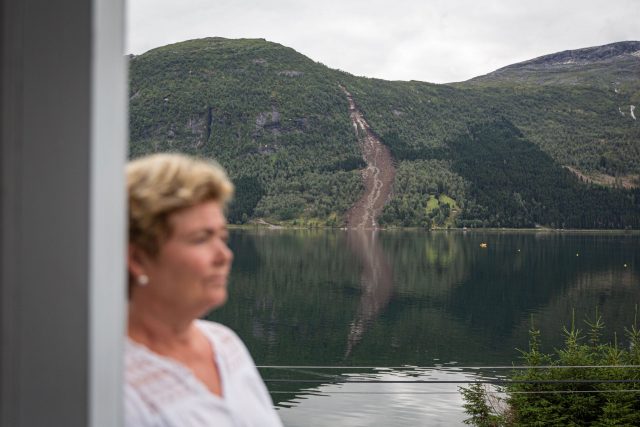1 August 2019
Sogn og Fjordane: a series of large landslides in Norway
Posted by Dave Petley
Sogn og Fjordane: a series of large landslides in Norway
Exceptional rainfall in both the United Kingdom and Norway have triggered substantial flood and landslide problems this week. In the UK, a large-scale evacuation remains in place as a result of the failure of the spillway of the Toddbrook Reservoir in Derbyshire. Efforts are underway to lower the reservoir level, but concerns remain that the dam could fail.
Meanwhile, in Norway record-breaking rainfall triggered a series of large landslides, primarily in Sogn og Fjordane county. One of these appears to have caused a fatality when a driver was caught in the flow at the foot of the slope at Årnes, with the car being swept into the Jølstravatnet lake. As yet the victim has not been recovered. Aftenposten has an article about this event, based upon the eye-witness report of a woman on the other side of the lake. It includes this image of the aftermath of the landslide:-

One of the landslides at Sogn og Fjordane in Norway on 30th July 2019. Image from Aftenposten.
.
Once again this appears to be a comparatively small failure on the upper slope, possibly consisting of a failure at the intact rock / regolith interface, which has then entrained slope material to become a debris avalanche.
Elsewhere, there was a series of similar failures. The most dramatic may well have occurred at Vassenden in Jølster, in which the landslide appears to have split the community in half. The image below is from NK, which has an excellent gallery of pictures of the landslides:-

The landslide at Vassenden in Norway on 30th July 2019. Image by Hallstein Dvergsdal, via NK.
.
NRK has a report of another series of the landslides, this time at Halvgjerda. The image below, also from NRK, shows the aftermath of the series of failures:-

The landslides at Halvgjerda in Sogn og Fjordane on 3oth July 2019. Image via NRK
.
A local lad, Jakob Slåtten, captured one of these in a dramatic video, which can be seen on the NRK page. It’s worth a look.


 Dave Petley is the Vice-Chancellor of the University of Hull in the United Kingdom. His blog provides commentary and analysis of landslide events occurring worldwide, including the landslides themselves, latest research, and conferences and meetings.
Dave Petley is the Vice-Chancellor of the University of Hull in the United Kingdom. His blog provides commentary and analysis of landslide events occurring worldwide, including the landslides themselves, latest research, and conferences and meetings.
Dave,
I generally think of trees contributing to the stability of slopes, however, I’ve heard a proposition that, as the trees grow and increase in mass, the weight of the forest may cause an increase in shear force (parallel to the slip face) and make mass movements more likely. What do you think?
Thanks
John Freeland
John, the added weight of water to the soil/slope increases the shear stress and loss of cohesion. Hence, the rock and soil will slide quicker under the force of gravity, both normal and tangential to the slope. Drainage is the issue, not the trees or root systems. Vegetation anchors the soil and keeps it on place. Your thoughts?
Receding permafrost in the soil due to climat change is probably a major contributing factor.